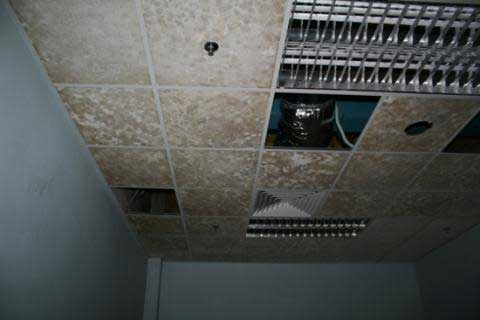Indoor Air Quality
Risk Mitigation Services

The Indoor Air Quality Problems
For hospitals in the tropical region, the main IAQ challenges usually arise from growth of mold and fungus – the same is true also for many non-hospital buildings. Identifying the root cause of this growth and helping to prevent it is our specialty area, as well as performing extensive mold remediation using 100% plant-based disinfection products that are safe for humans. Photo above is a typical appearance of mold on ceilings.
Understanding Microbial contaminants – spotlight on mold & fungus
Mold growth can occur almost anywhere, that’s why special consideration to mold issues have to be taken in constructing, maintaining and operating buildings.
Examples for mold growth in hospital ventilation systems:


Mold frequently grows on cold spots due to condensing moisture:


Mold growth is sustained through high relative humidity, for example due to fresh air intruding into air-conditioned zones in ceiling spaces:
What’s so bad about mold?
Molds produce allergens, irritants and toxins which effect human health. What are the effects?

Minimising above effects is important to keep up productivity, personal comfort and health at the work place. For hospitals and aged people’s homes the situation is even more severe, since people have weakened immune systems. Failing to maintain acceptable Indoor Air Quality in a hospital ward for example may result in additional infections and complications.
How Mold Grow and Spread?

The Sick Building Syndrome
To describe symptoms of bad Indoor Air Quality, the term “Sick Building Syndrome” is well known as is illustrated below:

What are the conditions for mold growth?

Our Indoor Air Quality Expertise at Your Service
Root Cause Analysis
One of the most important aspects of any IAQ improvement effort such as mold remediation is to identify the root cause that contributed to a current problem. If this step is missed or neglected, no client will be happy for long because the unfavorable conditions will eventually return. In some cases it may seem possible to skip the root cause analysis and patch up the symptoms (such as high bacterial/fungal counts) by means of disinfectants (see Continuous air-disinfection), but the pros and cons have to be weighed up very carefully: normally this would only be recommended as interim solution.
The root cause analysis must be performed by experts such as our team at GLWC who have a thorough understanding of a wide range of topics including:
- the physics of relative humidity in air
- building materials and typical building “mistakes”
- air-con system operation, maintenance and design
- human behavioral patterns
- climatic conditions
- and many more practical considerations…
Continuous Air-Disinfection
Microbe-related Indoor Air Quality problems such as fungus, mold, bacteria and viruses can sometimes be treated with continuous air-disinfection. This system can also be used to prevent the spreading of infected areas into other zones. Below is a list of typical systems for continuous air-disinfection:
- Gel-blocks that continuously release disinfectant into the air stream. Usually these blocks are placed inside air handling equipment or in the supply air line. GLWC uses blocks based on tea tree oil which pose no threat to human health but provide excellent protection against the spreading of infections. A residual protection is provided also to indoor surfaces because the gel-blocks leave behind an invisible and unnoticeable layer of disinfectant throughout the rooms. This effect is often sufficient to suppress returning mold.
- UV sterilizers that disinfect the air circulated by ventilation systems. These systems, if designed and maintained correctly, can also effectively prevent the spreading of infections. These systems have no residual protection to protect indoor surfaces.
- Air purifiers that filter and disinfect the air (often the disinfection is also based on UV). These systems have largely the same pros and cons as UV sterilisers.
- Some countries allow periodic injection of ozone into the indoor air. This system provides a good microbe kill but only little residual protection since the ozone breaks down within seconds and within few meters of the injection point. Effective mold prevention is unlikely to be achieved. GLWC does not recommend this method as it can be aggressive to our respiratory systems.
If you think your facility may require help from IAQ experts, please don’t hesitate to contact us.
